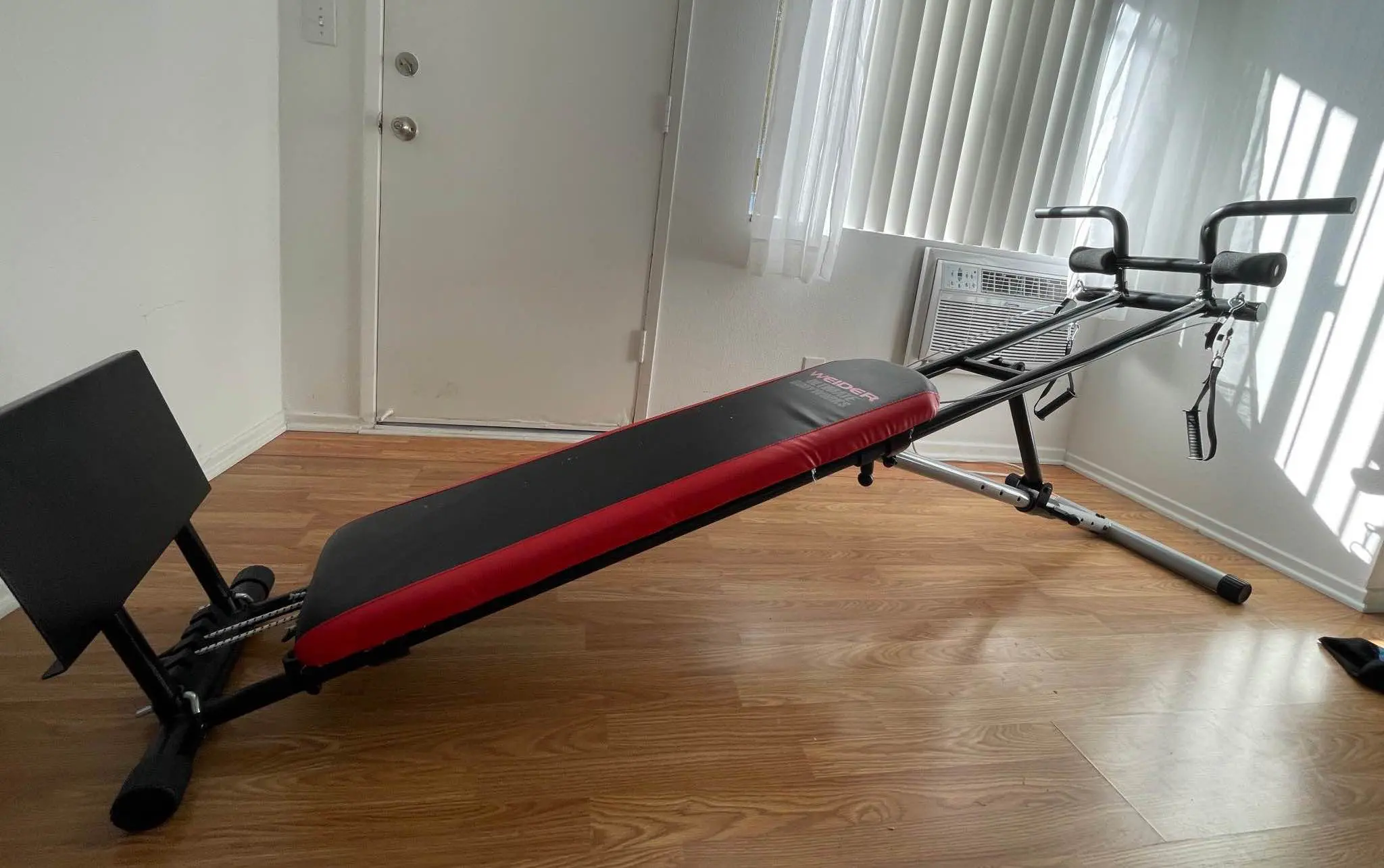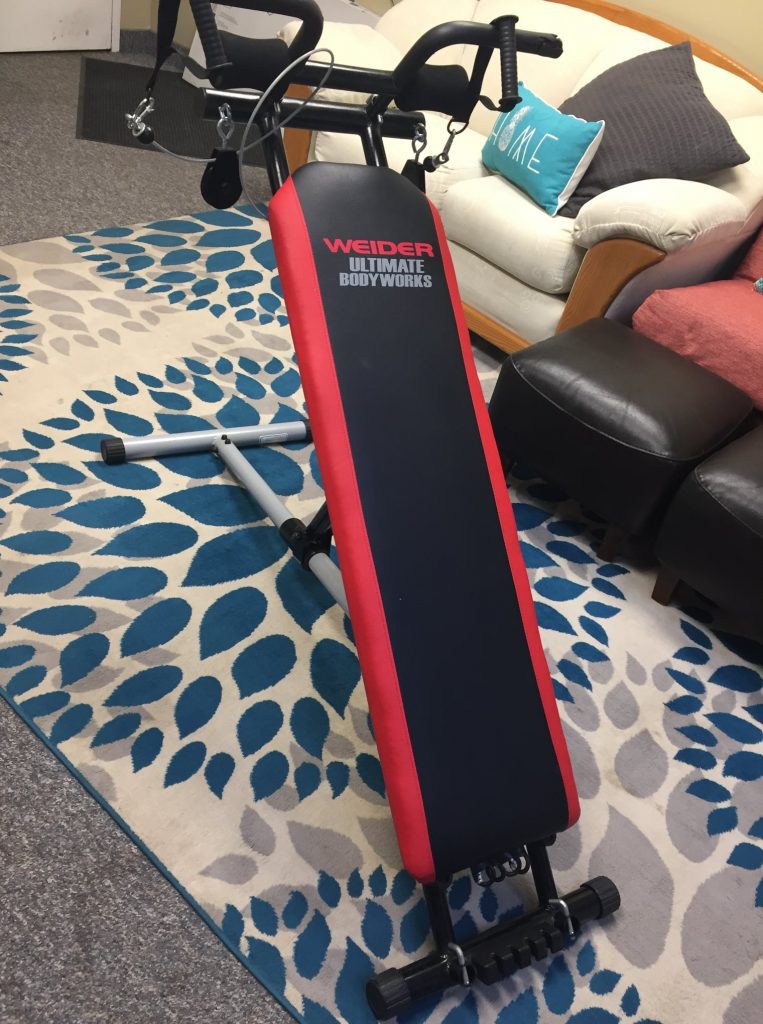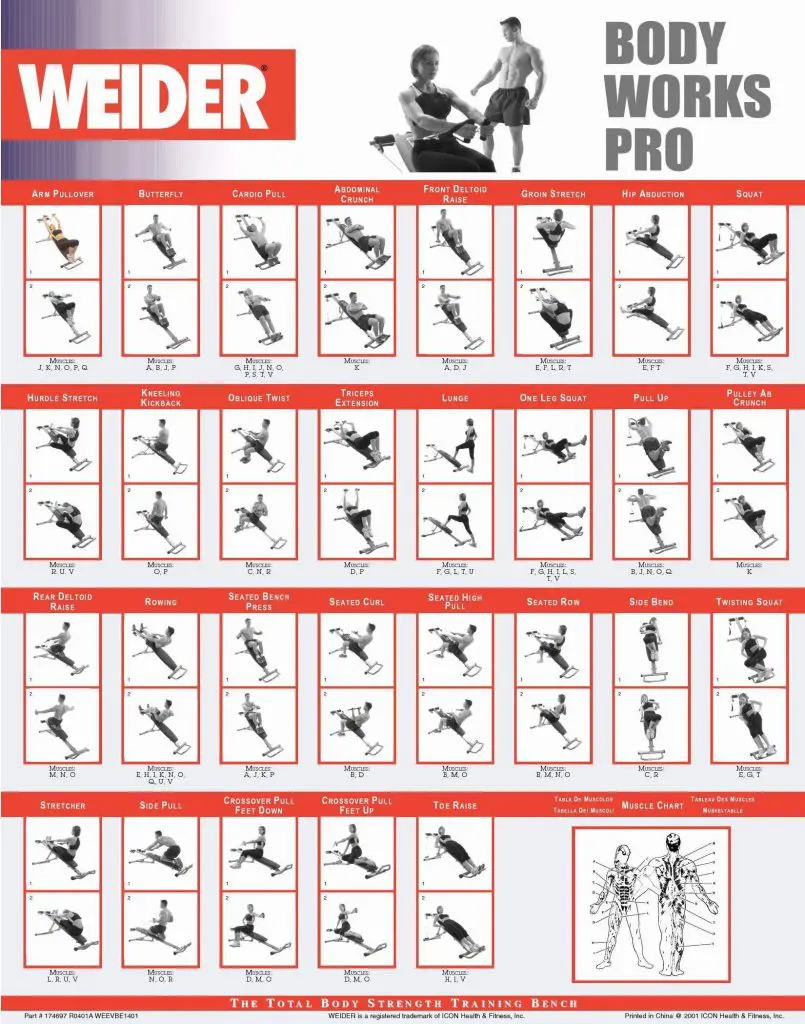
The best online fitness resource you'll ever need. We filter out the BS to ensure you meet your health and fitness goals!

The best online fitness resource you'll ever need. We filter out the BS to ensure you meet your health and fitness goals!

Workout equipment has been evolving for decades. We’ve come a long way from those round circus barbells.
Weight machines first officially made the scene back in 1957 with Harold Zinkin’s Universal Gym. Available square footage, safety, and appeal to novices drove those early designs and still do today.
Home gym equipment’s been evolving too. You may not be old enough to remember the cement-filled barbell plates and dumbbells that required a special key to change their plates. If you lost the key…well.

The Weider Ultimate Body Works machine is a hybrid sit-up board, leg sled, and cable machine, doubles as a bench. Other users have actually classified it as a bench, which is fair.
Its design is reminiscent of long board incline benches once common in gyms of the ‘60s and ‘70s.
A cable and pulley system is connected behind and underneath Ultimate Body Works, and cables can be added to increase resistance. (Absolute resistance would vary based on the combination of bodyweight, incline, and the number and physical drag on the bands). The support piston provides a range of incline angles ranging from flat to standing.
Finding a category for Ultimate Body Works becomes a bit challenging, because it functions as a straight board, a sled, and a bench.
We’ll refer to the machine as any of the three in this article, depending on application. Technically speaking, it’s a multi-gym, a little too vague to get an idea of what you can do with the Weider.
Weider has a visual chart of 31 exercises you can do on the Ultimate Body Works. You can click on the links below to download a printable copy.
>> Download printable PDF here <<
>> Download printable image here <<

The chart features two photos for each exercise, one showing starting position and the second showing the finish, and includes an alphabetical legend to muscles worked for each exercise.
Here’s a rundown of the 31 exercises you can find on the printable Weider Ultimate Body Works Exercise chart. We’re including our own “what it works most” at the end of each exercise to summarize the muscles you’d be working.
Set the board on about a 45 degree incline. Lying supine, back against the board, grip the cables overhand and with arms straight, pull down toward your hips, palms down.
What it works most: lats, teres major.
With the board at an angle, feet on the “down” end, grip the cable handles on either side of the body and with palms facing forward, bring your hands together so that your knuckles meet a few inches above belly button level).
What it works most: pec major.
This is set up like the Arm Pullover (above) except that feet are not on the board and are on the lower frame of the Ultimate Body Works, and the legs play a role.
With hands gripping the handles as before, press up with the legs while simultaneously pulling down with the arms.
This is a shoulders-to-toes exercise and the cardiovascular demand can get pretty intense, depending on board angle and number of reps.
What it works most: lats, teres major, legs, cardiovascular system.
With the bench at an angle, lie back on the board with feet on the base. Perform a traditional crunch, except your head will be on the high side of the incline.
What it works most: rectus abdominus (aka “the six pack”, unless of course genetics gave you a four pack or eight pack.)
Sit high on the bench facing forward. Grip the cable handles with palms down and with elbows straight, raise your arms out in front. To more directly hit the anterior deltoid, rotate the forearms so that palms are facing each other, or palms up. This orientation aligns the anterior deltoid more perfectly against resistance, isolating it more intensely.
What it works most: anterior delts.
Sit facing the pulleys with legs crossed on the board in front of you, gripping the handles at arms’ and body’s length, so that you are bent forward face down. Your torso should be almost touching your legs in the “down” position. Pull yourself up, flaring your elbows to the side, similar to a face pull.
What it works most: rear delts, stretches the adductor magnus.
Face the pulleys seated with legs straight in a “V” off to each side of the board. Hold the cables and pull yourself upward by bringing your legs out to the sides as much as possible. The sled should slide toward the pulleys a few inches.
What it works most: glute max.
The Ultimate Body Works squat is really just a hack squat, and performed exactly the same way. Stand with feet on the foot plate, with back against the sled board, bend knees and descend as deep as you’re able, then press back up to nearly standing.
Avoid locking out at the top to maintain good time under tension.
What it works most: quads, glutes, hamstrings, adductors.
Assume a hurdler pose by sitting on the board with one leg straight in front of you on the board and the other bent underneath the straight leg. Holding the handles, let your upper body come forward and the board slide backward until your upper body is almost touching your legs.
What it works most: stretches the posterior chain.
Kneel facing forward toward the top of the Body Works, gripping the cable handles palms down with arms bent 90 at the elbows. Press down and back, extending the arms like in a triceps pushdown. The board will move up the rail as you push down.
What it works most: triceps.
Sitting side-saddle on the board, grab the cable handles with an interlocking “golfer” grip with arms bent in front of you. Pull your forearms across your body toward the “down” side of the Body Works. As you pull down, the board will move up.
What it works most: internal and external obliques.
Lying face-up with feet on the board, hold the handles with arms bent as you would if doing triceps extensions with an EZ Curl bar or dumbbell skull crushers.
Press out and up, just like a traditional lying triceps extension.
What it works most: (spoiler alert) triceps.
Stand with one foot on the floor and the other in front, placed on the sliding board, with leg bent at roughly 90 in front. Lean forward so that your lead leg tracks forward.
Push down and pull back with your hamstrings and glutes to bring your lead leg (and the board) back toward you.
What it works most: glutes, hamstrings, adductors, quads.
This exercise could also be termed the Body Works Pistol Squat, or Single Leg Squat.
Lie back on the sled with one foot on the foot plate and the other held in space over the plant foot. Tensing the planted leg, lower yourself under control as low as you’re able and then press back up, keeping the non-working leg straight.
What it works most: quads, adductors, glutes, hamstrings.
Lying prone on the board with your knees bent so that your feet aren’t touching the sled, grip the handle bars as widely as possible, and pull yourself up and forward.
What it works most: lats, T3 and T4 trapezoid insertions, teres major, brachialis major.
Think seated ab machine at the gym.
Lie back on the Body works with feet up on the board. Grip the handles overhand with palms facing back over your shoulders and arms bent so that your upper and lower arms are touching. Crunch forward while keeping your arms fixed in the bent position.
What it works most: rectus abdominus.
Get in a kneeling position high on the board, facing the pulleys and handlebars. Grasp the handles palms facing. With arms straight in front, pull backward until arms are perpendicular to your upper body at your sides. Palms should be facing forward, knuckles toward your back.
Hold the rep at the top for a second or two to get additional time under tension and an isometric benefit on the posterior deltoid and rotator cuff.
What it works most: posterior deltoid, infraspinatus, middle trapezius.
The rowing technique on the Ultimate Body Works intuitive: sit or kneel facing the pulleys (and handlebars), grab the handles, lean back, and row.
Raise the board for more resistance. This is an exercise where this machine shines. Traditional rowing machines are set at 0. In other words, flat. The Weider machine lets you increase resistance to create a bodybuilding cable row, or, try steady state cardio rowing on an incline for a real challenge.
What it works most: posterior delts, middle trapezius, lats, teres major, brachialis major.
Sit with your back to the pulleys and handlebars and feet flat on the board, grip the handles and press straight out. Or, press downward to turn the exercise into a decline press and work the pecs in their natural biomechanical orientation.
What it works most: pectoralis major, anterior deltoids, triceps.
Sit on the board facing the pulleys and handlebars, with legs hanging off the sides of the board. Grab the handles and curl.
The machine lets you apply cool variations to the curl.
What it works most: biceps, brachialis, brachioradialis.
Sit facing the handlebars with legs hanging off the sides of the glide board, and grip the cable handles overhand. Lean back at the waist (in other words, recline) ~45 and pull the handles toward your shoulders, bending your arms at the elbows.
Depending how high you pull your forearms, you can make the Seated High Pull a Face Pull, or more of an Upright Row. Some lifters prefer a hands-together raise where the finish is up near the forehead. You’ll feel that version in your upper traps. A lower hand/forearm position tends to load the deltoids more.
Varying your degree of recline shifts focus to upper back or deltoids. The farther back you lean, the more you’ll load the delts, since you’d be turning the move into a reclined front delt raise, more or less.
What it works most: posterior delts, middle delts, upper traps (T1 and T2).
Sit in the same position described above for the Seated High Pull, but more upright. Keep forearms low and pull back. You know: row. Not a lot of description required. Squeeze your shoulder blades together at the end of the move to work the middle and lower trapezius.
You can raise or lower your arms for comfort, but you’ll be working the same muscles.
Most operate under the belief that the seated row is primarily a lat exercise, and they’d be partially correct if talking about the first half of the motion. However, once your elbows are at your sides, the lats have pretty much done their thing, and the posterior delts and other shoulder extensors take over. The lats play no role in extending the humerus behind the back.
What it works most: lats, posterior delts (and other hidden shoulder extensors), middle and lower traps (T3 and T4).
Lie back on the glide board with knees bent, flat on the lower end of the board. Grip the cable handles in a comfortable way: you’ll probably find that underhand or neutral is best.
Now, bend to the side, using your core—specifically the obliques—as the prime mover. Let the “trailing” side arm relax on the cable and straighten the arm on the working side (without turning it into an arm press).
Resist the temptation to pull up with your feet, which would turn this into a hamstring exercise unintentionally.
There’s a lot going on here and may require a little practice to master, to avoid working body parts other than your obliques.
What it works most: obliques, other core stabilizer muscles.
Set the board to a relatively steep incline, and lie on your side with feet in a staggered stance on the foot plate. If your right side is on the board, put your right foot forward, with your left foot slightly back of the right.
Now, squat. Your hips will rotate naturally toward the board. It’s OK if you come up on the balls of the feet a bit, as with a sissy squat. That will only intensify the effect on the quads…a good thing.
What it works most: quads, glutes.
The Stretcher can be a very satisfying way to loosen tight lower back muscles.
Sit facing the handles with legs in front of you. Grab the handles at arms’ length and let your hips guide the board backward gently. Start with a small range of motion and gradually increase the backward glide until your torso touches (or nearly touches) your legs.
Be cautious if you’ve got pre-existing lower back problems to avoid re-injury. Under no circumstances should this be turned into a fast-moving, ballistic exercise.
Pro tip: warm up any muscle before you stretch it. Stretching a cold muscle invites injury.
What it works most: spinus erectors, lats.
Kneel on the board facing the handles. Grip the handles comfortably: overhand, neutral or underhand are all fine. Let the board glide backward until your arms are straight and you’re leaning forward over the board.
Now, simultaneously pull back row-style, and use your core to drive your knees back underneath until you’re back in the starting position.
Using sound mind-muscle connection, you can use arms and back more by focusing on them doing the work; or, you can make this more of a core move, similar to an ab wheel roll-out.
What it works most: brachialis, lats, obliques, rectus abdominus, spinus erectors.
This is a cross-body movement, meaning you’ll be reaching across your body with one arm and pulling against resistance to the other side. To use clinically-correct terminology, you’ll be pulling contralateral to ipsilateral.
Set the cable resistance for a single-arm movement. Lower the board incline to allow you to sit side-saddle with feet flat on the floor. Reach across your body with your left arm and grip the handle that’s now near your right side. Use a neutral grip such that your thumb is toward the ceiling.
Pull straight-arm across your body toward your left. The board will glide upward as your shoulder moves into extension.
This exercise looks way more complicated when written than in pictures, so be sure to consult the exercise chart for visuals. It will make complete sense once you see it.
What it works: posterior delts, infraspinatus.
The Feet Up version of the Crossover Pull is the same in almost every respect as the Feet Down version.
What’s different:
What it works most: middle and posterior delts.
Yes, you can even work your calves on the Ultimate Body Works. The Toe Raise is how.
Set the board at an appropriately steep incline, the greater the incline the more the resistance. Stand on the footplate, and press up with the balls of your feet, exactly as if you were using a traditional standing calf raise machine.
Holding dumbbells or barbell plates to your sides would make sense to add resistance as needed.
Since the amount of weight you’ll be able to do is a bit limited here, consider high-rep sets to volitional failure.
What it works most: soleus, gastrocnemius (aka, the calves).
As you’ve seen, the machine enables its user to do a number of moves, and there are many more exercises possible than are shown in the printable guide. Ultimate Body Works’ design makes it a playground for any gym equipment MacGyver-er. With just a few dumbbells and resistance bands, the list of possible exercises expands tremendously.
Here are a few examples right off the tops of our heads:
With a little thought and ingenuity, you’ll be able to think of others, always considering safety. Standing on the board would never be advisable. We found nothing suggesting it’s designed for balance work.
Ultimate Body Works folds up into a flat form factor reminiscent of an ironing board, so it can fit upright in a closet, or flat under a bed.
Hardcore lifters may balk at anything compact out of skepticism over lack of ruggedness. The product has a 250 lb. weight capacity, making it sturdy enough for most people.
The cable-and-pulley system, the adjustable incline, and any other portable gym equipment you could use with it, provide the exerciser with a respectable range of resistance.
It’s easy to progress or digress workout intensity by varying the sled angle or the number of pulleys used, or by using single-side or bilateral movements.
Adjust the bench angle and pulleys to vary resistance and number of reps. The higher the angle, the greater the resistance and theoretically fewer reps, and vice versa.
OK, let’s face it. Sometimes we’d rather just work out from home. You get off work at exactly peak gym time and can’t deal with the crowd, or the weather’s terrible and you’d just like to squeeze in a resistance routine instead of a run, or the outdoor workout you do in the park. The Weider Ultimate Body Works works great for those situations.
In summary, home gym equipment has come a long way since those early chrome and Naugahyde benches and cement-filled weights of the ‘70s. The folks at Weider led the way back then and continue to find ways to innovate, to make exercise equipment more user-friendly and bring fitness closer to home.